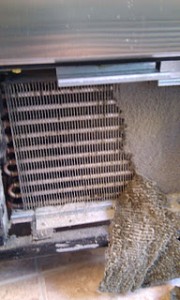The following is a short, but extremely important, list of things end-users can do on their own to reduce power usage and extend the life of their commercial refrigeration units including coolers, freezers, and ice machines.
This list is easy to check, and critical in maintaining proper product temperature. If, after reading this, you should have any questions please feel free to contact us!
1: KEEP CONDENSER COILS CLEAN:
This includes condensers on coolers, freezers, and ice machines! The condenser coil is the heat exchanger on refrigeration units. It’s the coil located on the outside of unit and expels the heat from refrigerant by passing it through a coil with the aid of a fan. It is ESSENTIAL TO KEEP THIS COIL CLEAN for proper operation of the unit. Failure to do so will result in expensive repairs including, but not limited to, compressor failure, fan motor failure, capillary tubing restrictions, burnt wiring and thermostat failure.
We recommend that the condenser coil be pressure cleaned by a service company at least every six months. In between professional maintenance users can clean the coil with a brush. The brush method does not clean within the coil though, and should not be considered a substitute for regular maintenance. On a kitchen line these coils may need to be degreased and cleaned more frequently. Self contained coolers and freezers usually have the condenser coil located at the base or on top of the unit. It can usually be accessed by removing 4 Phillips type screws at the corners of a cover. Ice machines generally have condenser coil located at rear of machine. It may have an air filter covering it, that should be washed. Routine inspection should be done frequently. A clean condenser coil is one way to GO GREEN by saving on power consumption and greatly prolonging the life of the equipment. The following picture is a condenser coil long overdue for cleaning. We see this on a daily basis.
2: UNIT CLEARANCES:
In order to maintain proper air flow around the condenser coil it is important to keep minimum clearances around units. Most factories recommend 2 to 4 inches of clearance around sides & back of self contained units. Our recommendation is the more clearance the better! We would like to see 5 to 8 inches of clearance around sides and the back of unit. We understand that space is limited in commercial kitchens. We also know that the more air that can freely move through the condenser section of a unit, the less power will be consumed and the longer vital components will last. Jamming coolers against one another and directly against a wall is a sure way to expend the most amount of energy and guarantee many problems. We do not recommend boxing coolers in under bars or any enclosure. Not only will this create airflow issues, but units that are built-in are extremely difficult and time-consuming to service.
3: GASKETS:
Your refrigeration has worked hard to achieve proper product temperature, why let the cold seep out? Routinely inspect the door gaskets (seals) on all coolers and freezers. Make sure all four sides of gaskets are making good solid contact with door frame. Check for tears, rips, or missing magnetic strips in gaskets. If gaskets are found to be worn out and not sealing well they should be replaced. The key to maintaining temperature and reducing run times, as well as power consumption is a good door seal. This is especially true in a hot kitchen!
4: DOOR HINGES & CLOSERS:
To ensure that doors on refrigeration units close properly most hinges have spring cartridges that assist in closing the doors. On larger coolers and freezers, especially walk-in equipment there may be a hydraulic door closer located at the top of the door on exterior section. Most cooks, and kitchen employees, are much too busy rushing orders out to be worried about ensuring doors are properly closed. This is why automatic door closers are so vital. If automatic door closers are not working properly then there is a good chance the doors are ajar. Doors that are not closed all the way will lead to excessive run time, inefficient use of energy, and shorten the life of the equipment. It will also cause the evaporator coils to ice up. Check your door closure operation by opening the door all the way and then gently pushing it closed. If closer is working correctly it should do the rest of the work and pull door closed. If door does not close on its own we recommend new hinges or closer hardware.
5: CALCULATE ACCURATE INTERNAL FOOD TEMPERATURE:
We recommend using a product sensing thermometer versus an air sensing thermometer in refrigeration units due to rapidly changing ambient conditions. Using an air sensing thermometer only tells you how cold the air is in a refrigeration unit at the moment you open it. There are times when it does not give an accurate picture of a product’s actual temperature. For actual average product temperature use Sure Temp Glycol filled thermometer. This thermometer is encased in liquid and will provide an accurate average temperature reading of the product in a conditioned space. After leaving the Sure Temp thermometer in a conditioned space for a few hours take a look and see what the temperature reading is. On a cooler 34- 40 F degrees is good. If it’s colder you can raise the thermostat to a warmer setting and thereby save energy. A freezer storing ice cream should be around -10 F. After establishing average temperature with Sure Temp thermometer adjustments to the thermostat can be made.
We hope this information has been useful and IF YOU HAVE ANY QUESTIONS about energy conservation, maintenance, or the Sure Temp thermometer in the Chicago area GIVE US A CALL AT: 847-409-3332.
← BACK TO ALL POSTS

